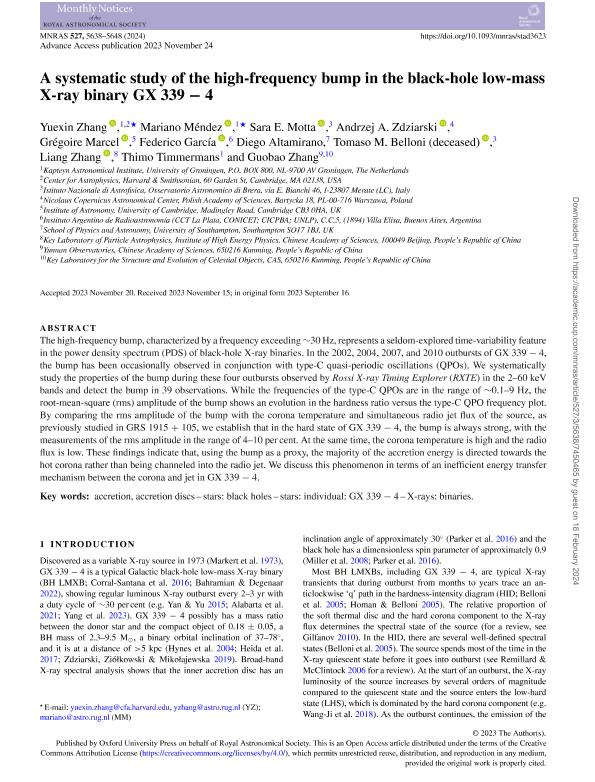Mostrar el registro sencillo del ítem
dc.contributor.author
Zhang, Yuexin
dc.contributor.author
Méndez, Mariano
dc.contributor.author
Motta, Sara E.
dc.contributor.author
Zdziarski, Andrzej A.
dc.contributor.author
Marcel, Grégoire
dc.contributor.author
García, Federico

dc.contributor.author
Altamirano, Diego

dc.contributor.author
Belloni, Tomaso M.
dc.contributor.author
Zhang, Liang
dc.contributor.author
Timmermans, Thimo
dc.contributor.author
Zhang, Guobao
dc.date.available
2024-03-21T15:05:41Z
dc.date.issued
2024-01
dc.identifier.citation
Zhang, Yuexin; Méndez, Mariano; Motta, Sara E.; Zdziarski, Andrzej A.; Marcel, Grégoire; et al.; A systematic study of the high-frequency bump in the black-hole low-mass X-ray binary GX 339 -4; Wiley Blackwell Publishing, Inc; Monthly Notices of the Royal Astronomical Society; 527; 3; 1-2024; 5638-5648
dc.identifier.issn
0035-8711
dc.identifier.uri
http://hdl.handle.net/11336/231205
dc.description.abstract
The high-frequency bump, characterized by a frequency exceeding ∼30 Hz, represents a seldom-explored time-variability feature in the power density spectrum (PDS) of black-hole X-ray binaries. In the 2002, 2004, 2007, and 2010 outbursts of GX 339 -4, the bump has been occasionally observed in conjunction with type-C quasi-periodic oscillations (QPOs). We systematically study the properties of the bump during these four outbursts observed by Rossi X-ray Timing Explorer ( RXTE ) in the 2-60 keV bands and detect the bump in 39 observations. While the frequencies of the type-C QPOs are in the range of ∼0.1-9 Hz, the root-mean-square (rms) amplitude of the bump shows an evolution in the hardness ratio versus the type-C QPO frequency plot. By comparing the rms amplitude of the bump with the corona temperature and simultaneous radio jet flux of the source, as previously studied in GRS 1915 + 105, we establish that in the hard state of GX 339 -4, the bump is al w ays strong, with the measurements of the rms amplitude in the range of 4-10 per cent. At the same time, the corona temperature is high and the radio flux is low. These findings indicate that, using the bump as a proxy, the majority of the accretion energy is directed towards the hot corona rather than being channeled into the radio jet. We discuss this phenomenon in terms of an inefficient energy transfer mechanism between the corona and jet in GX 339 -4.
dc.format
application/pdf
dc.language.iso
eng
dc.publisher
Wiley Blackwell Publishing, Inc

dc.rights
info:eu-repo/semantics/openAccess
dc.rights.uri
https://creativecommons.org/licenses/by-nc-sa/2.5/ar/
dc.subject
ACCRETION, ACCRETION DISCS
dc.subject
STARS: BLACK HOLES
dc.subject
STARS: INDIVIDUAL: GX 339 -4
dc.subject
X-RAYS: BINARIES
dc.subject.classification
Astronomía

dc.subject.classification
Ciencias Físicas

dc.subject.classification
CIENCIAS NATURALES Y EXACTAS

dc.title
A systematic study of the high-frequency bump in the black-hole low-mass X-ray binary GX 339 -4
dc.type
info:eu-repo/semantics/article
dc.type
info:ar-repo/semantics/artículo
dc.type
info:eu-repo/semantics/publishedVersion
dc.date.updated
2024-03-15T14:43:54Z
dc.journal.volume
527
dc.journal.number
3
dc.journal.pagination
5638-5648
dc.journal.pais
Reino Unido

dc.description.fil
Fil: Zhang, Yuexin. Harvard-Smithsonian Center for Astrophysics; Estados Unidos
dc.description.fil
Fil: Méndez, Mariano. University of Groningen; Países Bajos
dc.description.fil
Fil: Motta, Sara E.. Osservatorio Astronomico Di Brera; Italia
dc.description.fil
Fil: Zdziarski, Andrzej A.. Polish Academy of Sciences; Polonia
dc.description.fil
Fil: Marcel, Grégoire. University of Cambridge; Reino Unido
dc.description.fil
Fil: García, Federico. Provincia de Buenos Aires. Gobernación. Comisión de Investigaciones Científicas. Instituto Argentino de Radioastronomía. Consejo Nacional de Investigaciones Científicas y Técnicas. Centro Científico Tecnológico Conicet - La Plata. Instituto Argentino de Radioastronomía; Argentina
dc.description.fil
Fil: Altamirano, Diego. University of Southampton; Reino Unido
dc.description.fil
Fil: Belloni, Tomaso M.. Osservatorio Astronomico Di Brera; Italia
dc.description.fil
Fil: Zhang, Liang. Chinese Academy of Sciences; República de China
dc.description.fil
Fil: Timmermans, Thimo. University of Groningen; Países Bajos
dc.description.fil
Fil: Zhang, Guobao. Chinese Academy of Sciences; República de China
dc.journal.title
Monthly Notices of the Royal Astronomical Society

dc.relation.alternativeid
info:eu-repo/semantics/altIdentifier/doi/http://dx.doi.org/10.1093/mnras/stad3623
dc.relation.alternativeid
info:eu-repo/semantics/altIdentifier/url/https://academic.oup.com/mnras/article/527/3/5638/7450465
Archivos asociados
